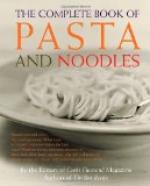[13] Thus, too, Scogin and his “chamber-fellow” successively declared to a rustic that the sheep he was driving were pigs. In Fortini’s novels, in like manner, a simpleton is persuaded that the kid he offered for sale was a capon; and in the Spanish El Conde Lucanor, and the German Tyl Eulenspiegel, a countryman is cheated out of a piece of cloth. The original form of the incident is found in the Hitopadesa, where three sharpers persuade a Brahman that the goat he is carrying for a sacrifice is a dog. This story of the Florentine noodle—or rather Poggio’s version—may have been suggested by a tale in the Gesta Romanorum, in which the emperor’s physician is made to believe that he had leprosy. See my Popular Tales and Fictions, where these and similar stories are compared in a paper entitled “The Sharpers and the Simpleton.”
[14] In Powell and Magnusson’s Legends of Iceland (Second Series, p. 627), a woman makes her husband believe that he is dressed in fine clothes when he is naked; another persuades her husband that he is dead, and as he is being carried to the burying-ground, he perceives the naked man, who asserts that he is dressed, upon which he exclaims, “How I should laugh if I were not dead!” And in a fabliau by Jean de Boves, “Le Villain de Bailleul; alias, Le Femme qui fit croire a son Mari qu’il etait mort,” the husband exclaims, “Rascal of a priest, you may well thank Heaven that I am dead, else I would belabour you soundly with my stick.”—See M. Le Grand’s Fabliaux, ed. 1781, tome v., pp. 192, 193.
[5] History of the Forty Viziers; or, The Forty Morns and Forty Eves. Translated from the Turkish, by E.J.W. Gibb, M.R.A.S. London: G. Redway, 1886.
[16] A variant of this is found in John Bromyard’s Summa Praedicantium, A 26, 34, as follows:
Quidam sedebat juxta igneum, cujus vestem ignis intrabat. Dixit socius suus, “Vis audire rumores?” “Ita,” inquit, “bonos et non alios.” Cui alius, “Nescio nisi malos.” “Ergo,” inquit, “nolo audire.” Et quum bis aut ter ei hoc diceret, semper idem respondit. In fine, quum sentiret vestem combustam, iratus ait socio, “Quare non dixisti mihi?” “Quia (inquit) dixista quod noluisti audire rumores nisi placentes et illi non erant tales.”
[17] Under the title of “The Phisitian that bare his Paciente in honde that he had eaten an Asse” this jest occurs in Merry Tales and Quicke Answeres, and Professor Crane gives a Sicilian version in his Italian Popular Tales.
CHAPTER VI.
THE FOUR SIMPLE BRAHMANS.
[As a sort of supplement to the sayings and doings of the silly son, the following highly diverting Indian tale is here inserted, from the Abbe Dubois’ French rendering of the Tamil original, appended, with others, to his selections from the Panchatantra. The story is known in the north as well as in the south of India: in the Panjabi version there are, however, but three noodle-heroes. It will be seen that the third Brahman’s tale is another of the numerous silent couple class, and it may possibly be the original form.]




